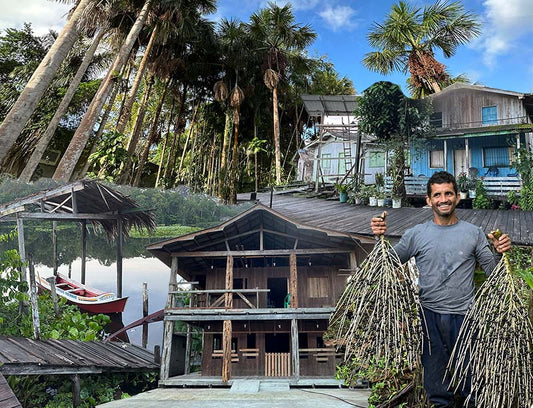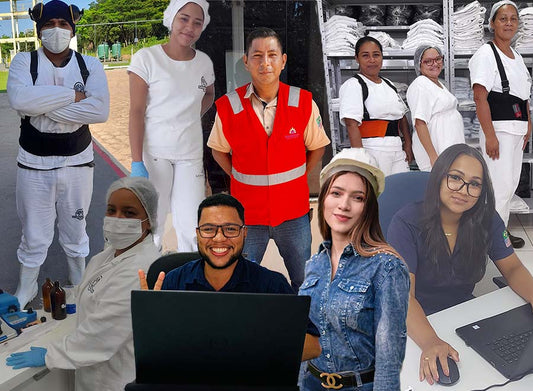Greenhouse Gas (GHG) Emissions are by no means an alluring topic to discuss, but it is an important conversation that needs to be brought to the table by companies who care about the planet. Here at SAMBAZON, we like to be upfront about the challenges we face as a global supplier of Açaí, and one of those ever-present challenges is how our activities contribute to our carbon footprint.
In being transparent, we hope to inspire other businesses to consider their social, environmental, and financial impacts and address some of today’s most challenging issues. Let’s dive into the data and learn more about SAMBAZON’s efforts to take care of the planet while spreading the Delicious Powers of Açaí on a global scale.
What are Greenhouse Gases?
Greenhouse Gases are gases like carbon dioxide that when released into the atmosphere cause the greenhouse effect. This is a natural warming of the earth that results when gases in the atmosphere trap heat from the sun. This keeps Earth’s climate habitable for humans and millions of other species. We have learned that human activities such as the burning of fossil fuels accelerate the production of these gases. This system is becoming out of natural balance and the fear is that it will no longer support the ecosystem as we know it.
Why is it important for SAMBAZON to measure GHG emissions?
SAMBAZON measures GHG Emissions for several reasons. First, it is one of our essential ESG (Environmental, Social, and Governance) metrics. ESG is a framework used to assess a company’s corporate policies and performance on sustainable and ethical issues to encourage companies to act responsibly. As a triple bottom-line business, we aim to protect the rainforest’s biodiversity and endangered species and keep the planet top of mind in our Açaí production chain. We know our ongoing measurements and disclosure of GHG Emissions is important to our consumers, employees, and investors.
We also know that many governments around the world are looking at how regulations can be used to encourage companies to reduce GHG Emissions. By measuring these now and understanding exactly what SAMBAZON activities are contributing to our carbon footprint, we will be able to proactively mitigate our contribution before new regulations take effect.
It is also critical that we and other companies quantify our climate risks. SAMBAZON Açaí is a wild harvested crop from one of the critical ecosystems on the planet, the Amazon Rainforest. Our products are flood irrigated by the natural cycles of the Amazon River. If the rain does not come causing droughts or we get too much resulting in above average flooding, then this would be disastrous for everyone and everything that lives there.
How do you measure GHG emissions?
“Carbon dioxide equivalent” is a standard unit for counting greenhouse gas (GHG) emissions. We calculate our emissions in tons of CO2e. TCO2e are metric tons Carbon Dioxide equivalent—A standard unit for counting greenhouse gas (GHG) emissions CO2e accounts for carbon dioxide and other greenhouse gases such as methane and nitrous oxide.
What is included in GHG inventory?
GHG inventories are split into three categories, or scopes. SAMBAZON calculates all three!
Scope 1 is direct emissions from owned or controlled sources, for SAMBAZON this includes fuels used in our vehicles, forklifts, boilers, generators, and refrigeration.
Scope 2 is the indirect emissions associated with the purchase of electricity, steam, heat, or cooling. The electricity SAMBAZON purchases to power our factories and offices is included here.
Scope 3 is all the other emissions resulting from activities that SAMBAZON does not own or control in our supply chain. For SAMBAZON some examples are emissions from the manufacturing of the materials we purchase, transportation of those goods and our finished products, employee commuting, the emissions from the waste generation, and it even accounts for how you use our products! We look at GHG emissions of home and commercial refrigerators and benders used by you and your local café to create delicious Açaí treats!
Where do SAMBAZON’s GHG Emissions stand for 2022?
Our Scope 1 of Direct Emissions is 3746 tCO2e, and this is a slight increase from 2021’s number of 3726 tCO2e.
Our Scope 2 of Indirect Emissions is 1202 tCO2e, which is an increase from 2021’s number of 578.
The reason for this scope 2 increase is the GHG emissions from electricity production went up due to changes in the mix of available power sources. The electrical grid in Brazil where our factories are located has a mix of renewable hydroelectricity and fossil fuels. Drought issues in Brazil required more reliance on fossil fuel plants, these plants release greenhouse gases. Ironically, these increased greenhouse gases can cause additional climate change creating a vicious cycle down in Brazil if alternative solutions are not found.
Obviously, there are many complex factors that go into why our numbers have changed over the years and this is a notable example of an increase that we cannot directly control. The good news is 77% of our electricity is from renewable sources! We can feel good knowing our electrical grid has a high rate of renewable energy. Knowing where our power is coming from and tracking what we are using is the first step in understanding how SAMBAZON directly contributes to GHG emissions.
Scope 3 is a challenging number to calculate as it requires data from many sources. We are working on our 2022 numbers. Our 2021 calculations are complete, and we are reporting 170,051 tCO2e, which was 98% of SAMBAZON’s total calculated GHG emissions. Food & Beverage companies usually have a much higher Scope 3 percentage of their overall GHG emissions, this is due to the complex supply chain needed to make these goods. For us the biggest category in Scope 3 was from ingredients and packaging we buy.
As we learn more about the impact of our supply chain, we are looking for efficiencies that we can implement, such as picking alternate transport like rail which has relatively lower overall emissions.
We are also working to find out from our suppliers if they calculate their Scope 1 and 2 emissions and asking them to share what that actual percentage is for SAMBAZON. This will improve our own calculations. Their Scope 1 and 2 become our Scope 3. A goal is to increase our supply chain engagement and work with partners to reduce their emissions as well.
What are opportunities for Emission Reduction?
A key value of calculating GHG Emissions is to understand highest impact areas and where opportunities exist for reductions. There are several different areas across each scope that we look to when considering ways that we can reduce our emissions. In Scope 1, we consider our refrigerants and if there are green alternatives or upgrades. At SAMBAZON operations, we look at our equipment to see if we can upgrade or move to more efficient options. We are always considering the GHG contributions when we make these decisions.
In Scope 2, we want to use renewable electricity. Options to procure 100% renewable electricity can be complicated but just like you may do for your own home we are looking at green purchasing programs, renewable energy certificates, and purchase power agreements.
In Scope 3, as mentioned earlier, we are looking at Stakeholder Engagement projects for our purchased goods and services. For transportation and distribution, we aim to engage our transportation options in finding efficiencies and programs to improve. For the use of sold products and their end of life, we aim to innovate products to be easier on the earth, as well as educate our consumers so they advocate for better options.
An example of this is our recent Açaí Smoothie Cubes innovation. This convenient Açaí option offers small cubes that don’t require a blender: all you need to do is add liquid to a shaker cup, allow them to thaw, shake, and your smoothie is ready. This eliminates the need for electricity to blend your smoothie or bowl, creating an overall more sustainable option for those looking to reduce their energy consumption. Learn more about this new product in our packaging blog.
What about carbon activity in SAMBAZON’s Certified Fair Trade and Organic Harvest Areas?
In 2018 we sponsored a team of scientists from the USA and Brazil to measure the trees in representative plots of our Certified Fair Trade and Organic Harvest Area. Using this data of the actual vegetation cover on this land we can now estimate the total amount of carbon stored in the SAMBAZON harvesting area. In 2022 we estimate this to be 7.5 million metric tons and includes both above and below ground carbon stores- think trees and roots.
It is important to note that this would not be a carbon offset for SAMBAZON. We cannot use this to compensate for emissions we make elsewhere. Right now, this agroforestry carbon store is not typically recognized as part of the carbon economy. We are hopeful that one day soon it will be recognized, and we can use this data to help sponsor carbon offset benefits for our harvesting community or explore carbon insetting.
Insetting is a relatively new concept, in short, it is giving a company credit for reducing emissions within their own value chain or doing better within your own business. In our case, we may find that following Organic and Fair-Trade harvesting practices and keeping the forests mostly intact adds additional value to the forest beyond the delicious Açaí. We are conducting more research and watching the developments closely to understand options for our company and communities.
What goals is SAMBAZON setting for the future?
Now that we are calculating our GHG emissions and starting to get baseline information we will start setting emission reduction targets that are achievable and realistic while also striving for the best possible outcome.
Phew! That was a lot of information about our carbon footprint! We are committed to doing our part to monitor our carbon footprint and to ensure that we are contributing to a sustainable future. We will continue to explore new and innovative ways to reduce our emissions and to make our business practices more eco-friendly. We recognize that the health of our planet and global community depends on the decisions we make today.
What did you find most enlightening from this deep dive into SAMBAZON’s GHG emission strategy? Share your thoughts with us in the comments below.








Comments
(0 Comments)Please note, comments need to be approved before they are published.